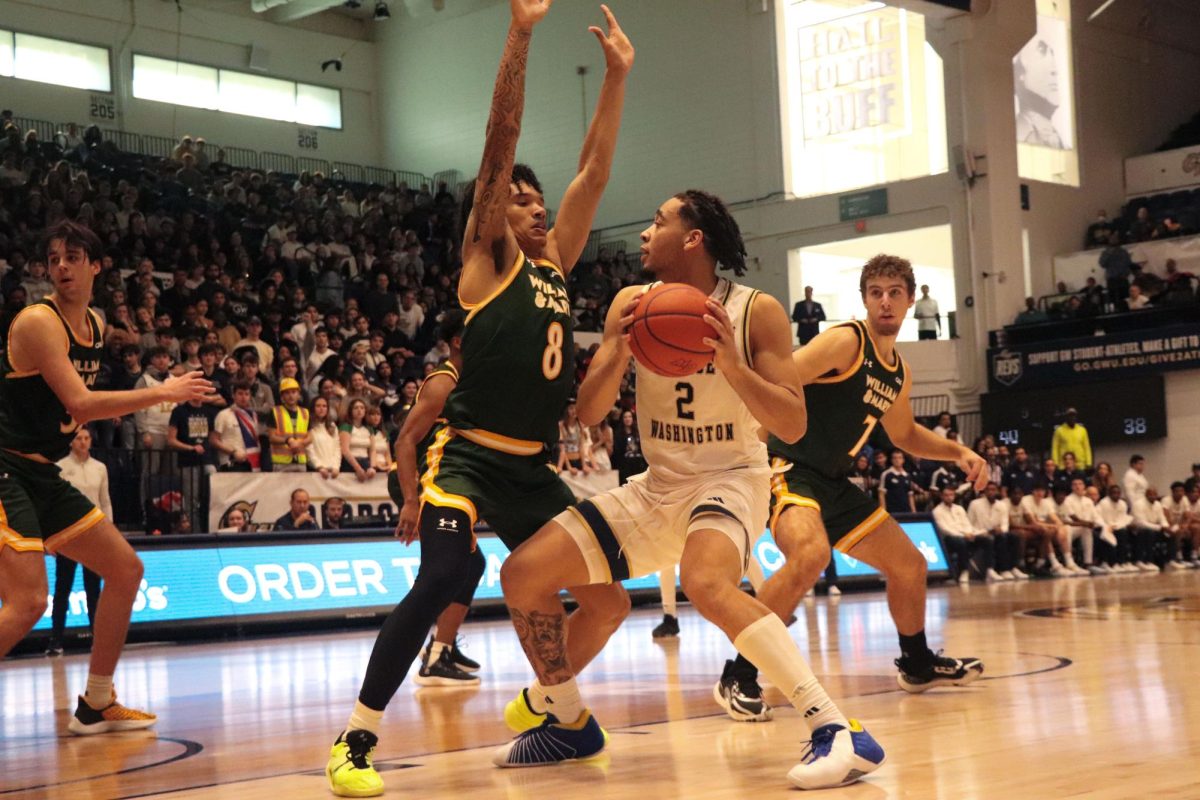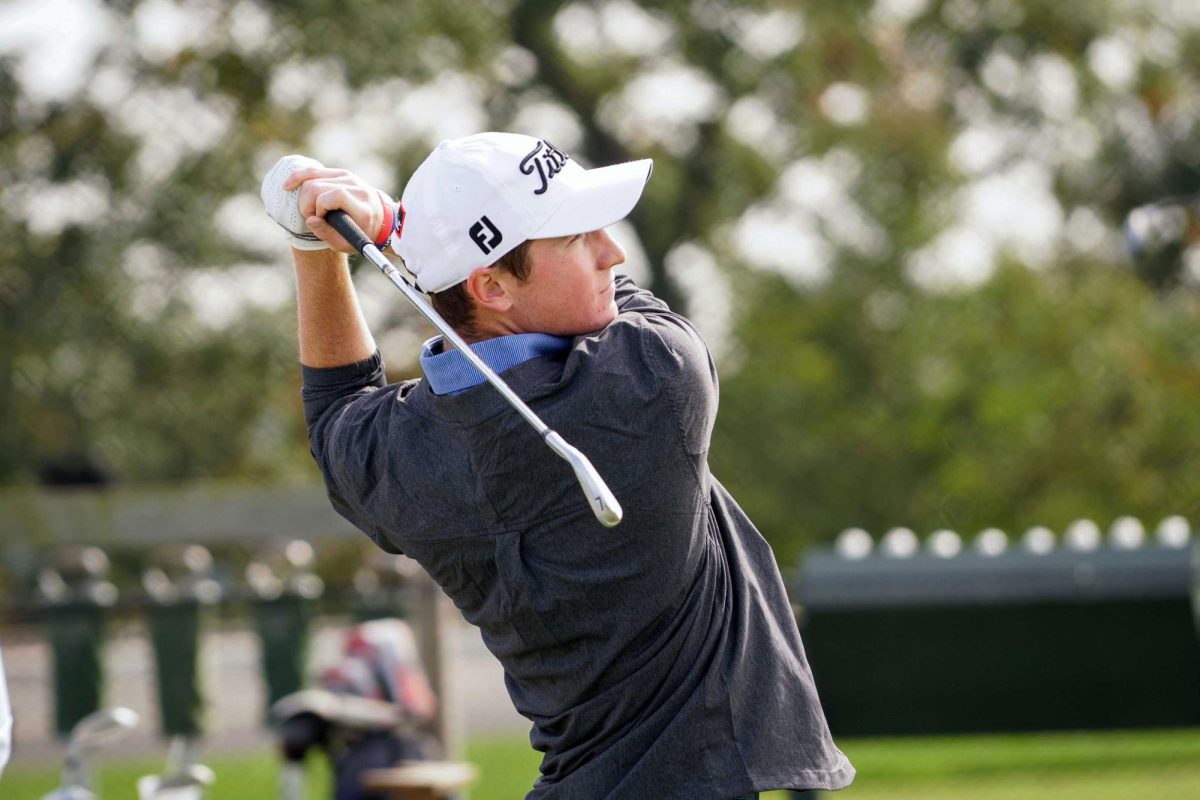“Rebuild” can be a loaded term in sports vernacular, a non-starter for the promise of the present, a built-in excuse for futility. Yet there it is, bold and white and capitalized on the first page of the official GW pamphlet shilling the men’s basketball program to prospective ticket holders, wordplay on a team and home arena in the process of being gutted from the inside and restructured in the name of improvement.
“It was sort of convenient,” explains Robert Chernak, GW’s senior vice president for Student and Academic Support Services, who oversees the athletic department. “I don’t know if you would necessarily gravitate toward that particular word if it wasn’t simultaneous with the renovation.”
Whatever the tie-in, nothing is more convenient than the truth and, in truth, rebuilding is what the men’s basketball program is doing as head coach Karl Hobbs enters his ninth season.
When he arrived in Foggy Bottom in 2001, he inherited a team awash in scandal and accompanied by low expectations. Then, a steady rise. An NIT berth in 2004. The next year, an Atlantic 10 title and a bid to the NCAA tournament. And the next, a year-long spot in the national polls, an undefeated conference season, the nation’s best regular-season record. In 2006-07, another 20-win season, another A-10 title, a third straight trip to March Madness.
Then, a sudden fall. In 2007-08, a seven-game losing streak, a 9-17 record, a 13th-place finish in the 14-team A-10. Last season, an 11-game losing streak, another 13th-place finish, another March spent without so much as a bid to their own conference’s postseason.
“We were sixth in the country,” Director of Athletics Jack Kvancz says, referring to GW’s peak ranking in 2006. “How in the Christ do we go two years without making the A-10 tournament?”
***
The search for answers began last winter, as the losses accumulated and a storm of discontent began brewing around the program. At the center was Hobbs, an excitable sideline-stomper whose reputation among GW supporters began to wane once winning had faded from frequent to rare.
As they do throughout the course of any season, Chernak and Kvancz engaged in a series of discussions, evaluating the job Hobbs was doing and the direction in which the program was heading.
At the end of the season, a decision had to be made: stay the course or embark anew under fresh leadership. The pair looked at the situation – the players in place, the incoming recruiting class, the benefits of stability in the always fluctuating college basketball world – and chose the former.
“We said, ‘hey, look, we still think we have the guy,'” Chernak says. “We have someone who understands recruiting, has the conduits. We just have to work with Karl and get him to understand that he has to do what it was that made him successful in the first place.”
“He’s done it. He’s done it,” Kvancz says. “He’s the same guy I hired with all the same connections. He’s just got to have better players.”
***
The variable was isolated. Hobbs would stay; everything else would change.
“We said, ‘Okay,’ ” Chernak says, “‘What is it that we would be able to do as administrators to assist Karl in getting back to the level of quality play that we want?’ “
Many of the desired solutions were already underway as Smith Center entered the second part of its three-phase, $43 million renovation process. This stage equipped the arena with brand new locker rooms and weight facilities, as well as a new court, better lighting, a revamped academic center – all the types of features that facilitate the recruiting process.
And then came all the little things: the outreach events, the proactive letters to fans, the Twitter accounts, the Facebook pages, the new concession stand hot dogs.
“Everybody has a role to play,” Hobbs explains, echoing sentiments from Chernak and Kvancz. “The students have a role to play, the marketing department, the ticketing department – it all comes down to a team concept.”
“It’s not Karl Hobbs’ basketball program,” he adds. “It’s the George Washington University’s program.”
At the base of the escalator in the Foggy Bottom Metro – a stop that previously bore posters touting nearby George Mason – a GW basketball ad carpets the floor. On it, redshirt junior Travis King and senior Damian Hollis flank George, the team’s hatchet-wielding mascot, with a rendering of the new Smith Center entrance circa next year at the center. Below them are a phone number and Web site; above them is a stylized “GW” beside a message.
“We’re both,” the ad reads, “on our way up.”
***
Three principles dictate Hobbs’s stewardship of GW’s men’s basketball program, defining what it means to be a member of his team. They are, in the words of their source, as follows:
1. You have a burning desire to want to graduate.
2. You have a burning desire to want to improve as a person and as a basketball player.
3. You have a burning desire to want to win and succeed.
“I tell every parent and player that I talk to that if you don’t buy into those things, please don’t come to GW,” Hobbs says. “Because I will end up not liking you and you will end up not liking me.”
So while Kvancz labels the remedy “better players,” Hobbs specifies that the program lacked “GW players,” guys who not only fit into his system of play – long, lean, athletic types capable of running the floor – but bought into his system of beliefs, and bought into all of them, not a select one or two.
Over the past two seasons, the program lost more than games, hemorrhaging enough players before graduation to field a full starting lineup. Veterans were dismissed without public explanation, underclassmen were transferred out of the program, and all the while, Hobbs rejuvenated his recruiting efforts, making sure to see more of incoming players himself and being sure to emphasize character as much or more than pure on-court talent.
He talked to teachers, chatted with guidance counselors, tried to evaluate a recruit’s friends, all in an effort to gauge the kinds of qualities he says his program lost sight of over the last few years.
“Even with all that, you sometimes can be wrong,” Hobbs says. “Kids can be complicated.”
Once the players were on board, Hobbs sent them a 20-page booklet describing what a GW player is, why they were coming here, what to expect here, how they should act and conduct themselves, and what their role would be on the team.
“That foundation needed to be reestablished,” Hobbs says. “That mission statement needed to be hammered home.”
***
Chernak has a story he likes to tell about Dwayne Smith.
He walked onto the Smith Center court one afternoon earlier this fall to take a look at the renovations; Smith, one of the team’s six freshmen this year, was shooting around at the time. He recognized Chernak, stopped his shooting, and walked over to tell the administrator that he remembered seeing him speak at Colonial Inauguration and thought he was funny, so he wanted to introduce himself.
Chernak, ever the basketball devotee, already knew all about Smith, that he’s from Canada and went to prep school last year, but the encounter left an impression on him.
“The nicest part about these guys is they see beyond themselves,” Hobbs says. “That’s how it used to be here.”
Many around the program are quick to point out the chemistry among this year’s team, never needing to reach very far to provide evidence. During the national anthem at Saturday’s exhibition game, the team stood not with its hands behind its backs, as in years past, but with arms draped across one another’s shoulders in embrace. While King played drums at October’s Colonials Run barbecue event, his teammates gathered around him to sing and dance.
And at this year’s Colonials Invasion season kickoff event, the team took the floor in all-white tuxedos to raucous applause, setting up in two lines to perform a choreographed routine that began with excerpts from Michael Jackson’s “Thriller.” They stepped, shimmied and slid in unison like the familiar music video zombies, reanimated and spirited.
“You can feel it in the air,” Chernak says. “You can feel an excitement that’s different.”
But buzz can only go so far. All the peripherals can be in place and the program can be renovated off the court, but the process will ultimately be judged by how it translates to the hardwood.
“Who knows what’s gonna happen this year?” Hobbs says. “What I do know is it’s gonna be a fun ride. I would encourage everyone to get on board this train. And once you get on board the train, when it makes a stop, don’t try to jump – no, no. Stay on the train. No matter what happens, stay on the train.”
As with any inexperienced team trying to gain its footing, Hobb’s ride will likely contain a predicted level of unpredictability. If Saturday’s preseason win was any indication, there will be both brilliance and blunders aplenty, often from the same player, sometimes on the same possession.
Thus, it is not necessarily results by which this team will be judged, Chernak says. This season will be evaluated in thirds, looking for progress and improvement as much as wins and losses.
Kvancz feels the same way.
“Shortsighted, I wanna win,” Kvancz says. “But I also have the patience to say, ‘Are these guys going to be good?’ Have we – and there’s that word – rebuilt this team?”







